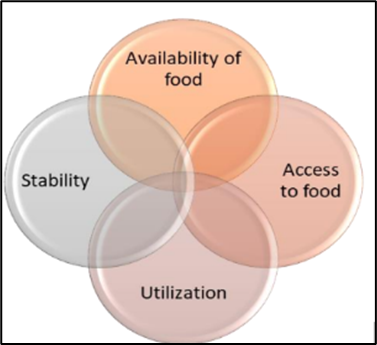Mains Daily Question
July 17, 2023
“India has transitioned from being a food-deficit nation to a self-sufficient food-producing country, but still it’s witnessing various challenges in attaining food and nutritional security”. Analyze.
Approach -
Introduction - Justify the statement that India is a self-sufficient food-producing country, but it's still witnessing challenges in attaining food and nutritional security.
Body - Briefly mention the various government programmes to address food and nutritional security in India. Mention the challenges that India is witnessing in attaining food and nutritional security.
Conclusion - Suggest a way forward.
Answer:
In the last 30 years, with a six-fold increase in food grain production from 50 million tonnes in 1950-51 to nearly 300 million tonnes in 2019-20, India has become a net food exporter, being the ninth largest exporter of agricultural products in the world.
But still, according to the Global Food Security Index 2022, India has a prevalence of undernutrition of 16.3% and as per International Food Security Assessment, 2022–32, India accounts for 65 per cent of the food insecure population in 2022-23.
Figure - Definition of Food Security by FAO.
Challenges in attaining food and nutritional security:
To achieve food security, the government has taken various steps i.e., National Food Security Act, 2013, PM-POSHAN Abhiyan, Integrated Child Development Services scheme etc. but still India is witnessing various challenges in attaining food and nutritional security.
- Climate change: The current stocks of wheat and rice in FCI godowns are to meet the operational requirements of the PDS for any quarter but on account of deficient monsoonal rainfall this year due to El Niño, the cumulative area sown under rice cultivation was 6.1% lower than the 131.23 lh covered during this time last year.
- Unstable groundwater levels: Deficient rainfall in the monsoon’s second half can impact the production of the upcoming rabi wheat crop. Also, about 30 per cent of the 5,723 administrative blocks in the country report that groundwater is at unsustainable levels. This is going to severely impact the availability of food in India in the upcoming future.
- Land degradation: More than half of the degraded land in the country is either rainfed farmland, responsible for the food security of the country. Large tracts of farmlands in India have become barren due to imbalanced fertilizer use and excessive use of a single fertilizer, urea.
- Limited Coverage under NFSA: The Supreme Court has directed the Government of India to increase coverage under the National Food Security Act, 2013. The court insisted that the government must consider the projection of population increase during the decade 2011-2021 so that benefits are not restricted to coverage as per the 2011 census. As, Right to Food is a fundamental right available under Article 21 of the Constitution of India.
- Fragmented food systems and inefficient supply chains: According to FAO, nearly 40 per cent of the food produced in India is wasted every year due to fragmented food systems and inefficient supply chains. E.g. According to the Ministry of consumer affairs, food and public distribution, between 2017 and 2020, 11,520 tonnes of food grains stored in government godowns rotted, resulting in a loss of about Rs 150 million.
- Food inflation: A recent report by ADB has found that a one per cent increase in food inflation leads to an increase of 0.3 per cent in both infant and child mortalities, and 0.5 per cent in undernourishment. The current monsoon vagaries and the ongoing Russia-Ukraine war is further going to increase food inflation and hence impact the affordability of food.
Way Forward:
- Sustainable groundwater management: To improve the groundwater levels in India we need to adopt interventions like rainwater harvesting, stormwater harvesting, rain gardens and bioretention ponds etc. and lastly we need to promote wastewater recycling to ensure sustainable groundwater management.
- Reclamation of degraded land: This involves restoring degraded land to its original condition or to a condition that is suitable for agricultural or other uses. Reclamation practices can include planting trees and shrubs, applying compost or manure, and controlling pests and weeds.
- Increase Coverage under NFSA: Following the Supreme Court's direction, the Centre should increase the coverage under the National Food Security Act, 2013 so that more and more needy persons and citizens get the benefit under the Act. To realize the Right to Food which is a fundamental right available under Article 21 the government must consider the projection of population increase during the decade 2011-2021 so that benefits are not restricted to the coverage as per the 2011 census.
- Minimize food wastage: To provide access to food to the have-nots, we need to adopt a Waste not philosophy. For this we must change our “food abundance” mindset to a “food scarcity” one, we need to ensure scientific storage of procured foodgrains, to move towards a zero-waste end goal.
- Addressing food inflation: The government needs to prioritize investments in modern irrigation systems, agricultural research, improving market infrastructure, strengthening market linkages for farm producers and establishing efficient transportation networks for distribution. This will help increase the food supply and reduce its price in the market, thus making it accessible to everyone.
India needs to attain Food and nutritional security as it is key to attaining the Sustainable Development Goals (i.e. SDG 2) and other high-level aspirational goals i.e. realizing the Right to food.


